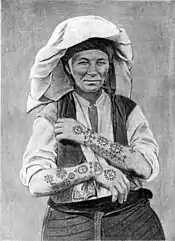
Sicanje or bocanje was a widespread custom mostly among Roman Catholic Croat teenage girls and boys of the central regions of Bosnia and Herzegovina, as well as the Dalmatia region of Croatia.[1][2] The phenomenon may predate the Slavic migration to the Balkans, and consequently Christianity itself, but it was possible to trace its appearance until the middle of the 20th century.
History


Tattooing of young girls and boys in Bosnia and Herzegovina is colloquially called sicanje or bocanje, and it was a widespread custom mostly among Roman Catholic Croats in the central regions.[3] The custom is thought to predate the Slavic migration to the Balkans and even Christianity.[4][5] In the 1st century BC, the Greek historian Strabo wrote of tattooing among inhabitants of this area, namely Illyrians and Thracians,[6][7] along with other customs.[8] Vlach women from Greece, Macedonia and Herzegovina also utilized tattoos.[9] Archaeologist Ćiro Truhelka researched these types of tattoos in the late 19th century, becoming one of the first to write about them and to illustrate them.[10][11] In 1894, a Bosnia-based doctor named Leopold Glück published an article in Vienna titled Die Tätowirung der Haut bei den Katholiken Bosniens und der Herzegowina (The Tattooing of Skin Among the Catholics of Bosnia and Herzegovina) detailing the tattoos observed among the locals.[12] Until the 20th century, also northern Albanians had similar tattoos.[13]
Women in some parts of the country tattooed their hands and other visible parts of the body (such as brow, cheeks, wrist, or below the neck) with Christian symbols and stećak ornaments. Also boys were tattooed with the same simbols mostly above the elbow on the right arm ,chest ,forhead and the pointing finger. This can be seen today, not only in Bosnia and Herzegovina, but among ethnic Croats from Bosnia and Herzegovina living abroad.[14][15] Children were tattooed from as early as the age of six, usually during the period between the feast of Saint Joseph in March to the feast of Saint John the Baptist in June.[16]
Designs
The most common symbols tattooed were the cross (križ), bracelet (narukvica), fence (ograda), and branches or twigs (grančica).[17] The cross had numerous variations, with one of the most common ones included small branch-like lines called "grančica" or "jelica" (pine tree). Bracelet-like designs were sometimes tattooed around the women's wrists, either with crosses or a fence-like motif. There were many non-Christian, or pagan symbols used, the most common consisting of circles believed to be connected to the traditional circle ("kolo") dances of the villages.[18] The pagan and Christian symbols were mixed together indiscriminately, with the first originating from nature and family in Illyrian times, and the other with later adapted Christian meaning.[18][17] The most common areas to tattoo were the arms and hands (including fingers), and on the chest and forehead.

Modern
The custom of tattooing young girls and boys died out after World War II with the establishment of the FPR Yugoslavia, and tattoos done by the traditional method are now only seen on old women.[19][20] Today, there is a growing trend of modern tattoo artists utilising the traditional designs with contemporary tattooing methods in Croatia and Bosnia and Herzegovina.[21]
In media
In 2013, a documentary titled Sicanje, bocanje, tetoviranje aired on Croatian television channel HRT 3.[20][22] In 2011, Vice published an article titled The Croatian Tattooed Grandma Cult about the phenomena.[23] Furthermore, Vice Serbia released a story and short film titled Tetovirane bake (Tattooed Grandmas), where they interview various Bosnian Croat women about their tattoos.[24]
See also
References
- ↑ "Traditional Croatian Tattoos: Meet the tattoo artist keeping tradition alive". 3 March 2021.
- ↑ "Traditional Croatian Tattoos". 4 March 2018.
- ↑ Jukić, Monika. "Tradicionalno tetoviranje Hrvata u Bosni i Hercegovini - bocanje kao način zaštite od Osmanlija".
- ↑ The Early Age of Greece; Cambridge University Press, p493-496
- ↑ Антанасьевич, Ирина. "Татуировки балканских женщин: украшение, исповедание или оберег?".
- ↑ Marija Maračić; Josipa Karača. "The Tradition of Sicanje in Bosnia and Herzegovina". Michael Schwartz Library | Cleveland State University. Retrieved 24 June 2022.
- ↑ Ćiro Truhelka:Die Tätowirung bei den Katholiken Bosniens und der Hercegovina (published in Wissenschaftliche Mittheilungen Aus Bosnien und der Hercegovina, herausgegeben vom Bosnisch-Hercegovinischen Landesmuseum in Sarajevo, redigiert von Dr. Moriz Hoernes, Vierter Band, Wien 1896)
- ↑ Albania and the Albanians: selected articles and letters 1903-1944, by M. Edith Durham, Harry Hodgkinson, Bejtullah D. Destani
- ↑ "Oldest Tattoo Shop in Greece by Lars Krutak". The Vanishing Tattoo. Retrieved 4 November 2020.
- ↑ Truhelka, Ciro. Wissenschaftliche Mittheilungen Aus Bosnien und der Hercegovina: "Die Tätowirung bei den Katholiken Bosniens und der Hercegovina." Sarajevo; Bosnian National Museum, 1896.
- ↑ Lipa, Aida (26 May 2006). "THE AUSTRO-HUNGARIAN PERIOD IN BOSNIA AND HERZEGOVINACultural Politics in Bosnia and Herzegovina and the Creation of the Western Type of Art" (PDF). Kakanien Revisited. Retrieved 4 November 2020.
- ↑ Glück, Leopold (1894). "Die Tätowirung der Haut bei den Katholiken Bosniens und der Hereegovina" (PDF). Wissenschaftliche Mitteilungen aus Bosnien und der Herzegowina. II: 455–462.
- ↑ Tirta 2004, pp. 68–70; Durham 2004, p. 94
- ↑ "Croats in Bosnia and Herzegovina". CROATIA - overview of. Retrieved 4 November 2020.
- ↑ Herzl Gaster, Theodor (1 January 1955). Customs and folkways of Jewish life. W. Sloane Associates. p. 256.
- ↑ Medić Bošnjak, Marija. "Stari običaj 'križićanje' ili "sicanje" izumire". Večernji list.
- 1 2 Rodríguez Rodríguez, Laura. "A tatuaxe sicanje: Resistencia católica ou paganismo herdado?".
- 1 2 Ralica, Iva. "Traditional Croatian Tattoos". Retrieved 19 December 2021.
- ↑ "Sa staricama odlazi i tradicija tetoviranja krsta u BiH". N1 Info. 30 December 2016.
- 1 2 Duilo, Dražen. "Sicanje, bocanje: što se skriva iza tetovaža na rukama baka diljem Bosne i Hercegovine".
- ↑ "Traditional Croatian Tattoos: Meet the tattoo artist keeping tradition alive". Croatia Week. 3 March 2021.
- ↑ "Sicanje, bocanje, tetoviranje (2013)".
- ↑ Hoban, Alex. "The Croatian Tattooed Grandma Cult". Vice. Retrieved 1 January 2022.
- ↑ Petrovic, Katarina. "Tetovirane bake".